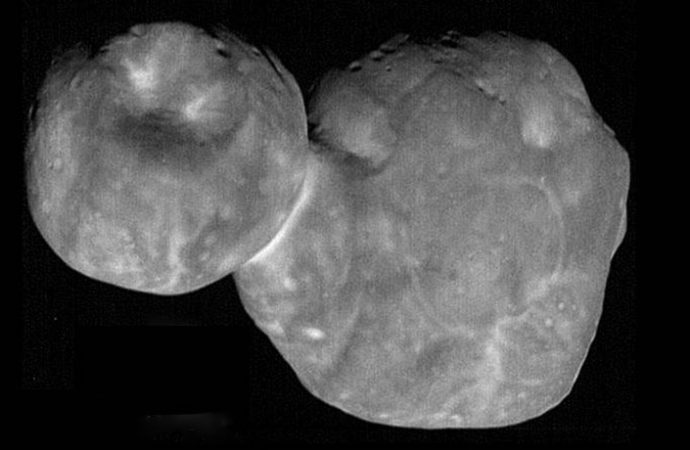Astronomers are closer to uncovering the distant space rock’s origin story
Source: Science News
Ultima Thule’s history may be written in the sum of its parts.
New analyses suggest that the tiny space rock formed from a rotating cloud of even smaller rocks that collapsed into two individual objects. Those objects then gently collided in the early days of the solar system, creating the distant double-lobed world studied by the passing New Horizons spacecraft, researchers reported March 18 at the Lunar and Planetary Science Conference.
NASA’s New Horizons flew by Ultima Thule, officially known as MU69, on January 1. The first images that the spacecraft sent back suggested a snowman-shaped world, with a larger lobe that the team dubbed “Ultima” and a slightly smaller bulb called “Thule”. But subsequent images showed that the lobes look more like flat pancakes or hamburgers than jolly snowballs.
The first map of the space rock’s geology may help explain that flatness. The map shows distinct mounds on both lobes whose borders are still visible today, planetary scientist Jeff Moore said at the meeting. Moore, of NASA’s Ames Research Center in Moffett Field, Calif., and his colleagues think that those mounds represent small or medium-sized rocks that organized themselves into a rotating disk before merging into two separate lobes that then collided. That rotation could have spread out material in a lobe, flattening it. “The disk was spinning … and that’s why we have the hamburger shape,” Moore said.
Planetary scientist William McKinnon of Washington University in St. Louis agrees, although he adds that “this has not been proven.” McKinnon also presented computer simulations of the final collision between Ultima and Thule that showed that the two must have been moving at about 2 meters per second when they collided. That’s about as fast as a person walking into a wall at a brisk pace, McKinnon said.

That gentle crash, plus the Frankenstein body, suggests that planetesimals like Ultima Thule form from clouds of dust and rock clumping together under the force of their own gravity. Before New Horizons, it wasn’t clear if these proto-planets formed from cloud collapse or from small rocks slowly sticking together to form larger rocks over time.
“I think it’s plausible” that clouds of rotating pebbles could have coalesced into Ultima Thule’s two lobes, says planetary scientist David Nesvorny of the Southwest Research Institute in Boulder, Colo. He and colleagues suggested in a 2010 study that collapsing clouds of small rocks in the Kuiper Belt — the distant zone of cold, primitive space rocks beyond Neptune’s orbit where Ultima Thule lives — could form close pairs of objects.
But the idea may not yet explain Ultima Thule’s flatness. “In my simulations back in 2010, I produced a lot of spheres,” Nesvorny says. Other researchers will now have to do new simulations that show that these rotating disks can lead to flat pancakes, he says.

































Leave a Comment
You must be logged in to post a comment.